 |
Twierdza Srebrnogórska
Srebrna Góra, Poland
|
|
 |
Constructed: 1765-1777
Used by: Prussia, France, Germany, Russia, Poland
Conflict in which it participated:
Napoleonic Wars
Also known as: Festung Silberberg
|
There's silver in them thar hills! The settlement of Srebrna Góra ("Silver Mountain") popped into being in the 14th century, supporting mines that collected silver ore in the surrounding mountains. Silver flowed and the settlement grew, obtaining city rights in 1536. |
 |
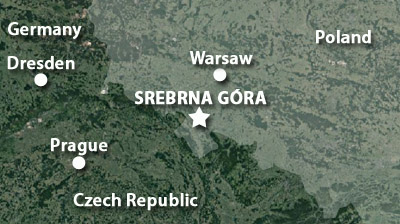 |
|
Later in the 16th century, however, profits from the mines dwindled...which either means that the silver dwindled, or that it was being mined with such wanton excess that prices dropped dramatically. The Thirty Years' War (1618-1648) did a pretty good job of destroying everything in Central Europe, and following that conflict the mines of our current interest were abandoned: The once-thriving citylet of Srbrena Góra shriveled to nothingness.
Silesia was an "historical region" of Central Europe, oriented for the most part along today's border betwixt Poland and the Czech Republic. Warsaw was Silesia's capital city, and Srebrna Góra was along Silesia's southwestern border, which was the border with the Kingdom of Bohemia. Silesia was rich in minerals and whatever passed for industry during this period, and in the 18th century it was more or less under the sway of Austria.
|
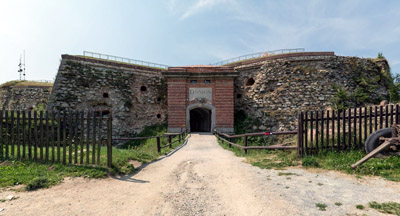 The main gate of Srebrno Górska's Donjon, or stronghold. Keep? Bastion? Something like that. The main part of the fort, let's just say. The main gate of Srebrno Górska's Donjon, or stronghold. Keep? Bastion? Something like that. The main part of the fort, let's just say. |
 |
Anything that Austria possessed in the mid-18th century was automatically a thing that Prussia wanted to take away from Austria (plus the Prussians did have some semi-legitimate dynastic claims to the region), and after the First Silesian War (1740-1742), Silesia became part of the Kingdom of Prussia. The Empire Struck Back, however, and two more Silesian Wars were held over the next couple of decades, but Silesia remained Prussian, and then German, until it was broken up in the 1920's.
Being as close to a border as it was, and being replete with valuable minerals as it also was, the Prussians wished to keep Srebrna Góra...it's starfortin' time! |
|
|
The messy but effective constellation of fortification that Prussia built in the Sowie (Owl) Mountains over Srebrna Góra, protecting the Przełęcz Srebrna (Silver Pass, through which today's romantically-named Road No. 385 runs), was not so much a fort as an interconnected series of fortifications. Prussian engineer Ludwig Wilhelm von Regler (1726-1792) was responsible for Srebrnagórska's design, with some later modification from Prussia's King Frederick II (1712-1786), Frederick the Great himself, who took a personal interest in this particular fort.
|
The focal point of Twierdza Srebrnogórska is the donjon, or keep...which is what we see at the top of this page. Historically, a keep was a castle's central tower, which served as both a defensive entity and residence for the castle's noble inhabitants: It was the fortification's nerve center. In essence, the individual bits and parts of our twierdza were different aspects of a fort but, being separated as they are, each is considered a fort in its own right.
Fort Donjon in the center was the brain of the operation; Fort Wysoka Skała was a hornwork that jutted up from the donjon to the northeast; Fort Rogowy, a similar hornwork that jutted to the west. Fort Chochoł Mały was a casemated fortlet further to the northwest.
|
 |
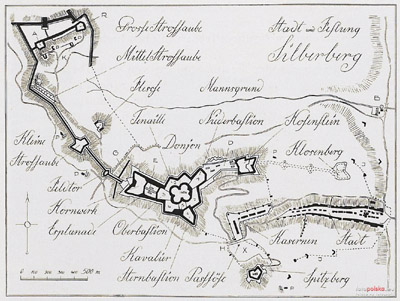 A map of the entire complex, in German, which was Twierdza Srebrnagórska's native tongue. Thanks, Fotopolska.eu! A map of the entire complex, in German, which was Twierdza Srebrnagórska's native tongue. Thanks, Fotopolska.eu! |
|
More batteries and a redoubt were built on a hilltop a little further to the northwest, and finally, Fort Ostróg looked over the whole shebang from the southeast. Any 18th century Prussians reading this will note that these are Polish names, and not the names that these forts would have been baptised with, but we're going with the Polish, because I like the word "twierdza" better than "festung," so get over it.
|
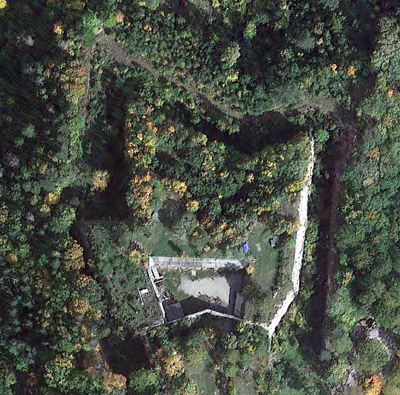
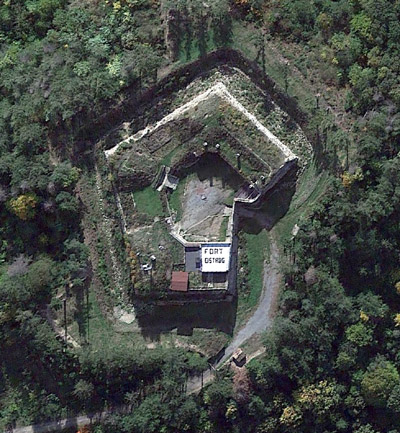 Twierdza Srebrnogórska's two most visible outposts today: Fort Wysoka and Fort Ostróg. |
 |
Squinting harder at the map above, one will note a dotted-line entity labeled Klosenberg, extending eastward from Fort Wysoka Skała...a proposed battery, tunneled listening post, stairway to heaven or general hideyhole? This entire complex was interconnected with a warren of tunnels and underground casemates, so anything is possible, except for manned flight, which wouldn't come along for another 130 years. Well, and nuclear fission. And a reliable cellular network. And now that I think about it, I guess a lot of things weren't possible yet, so please ignore that statement. Our twierdza had a total of 299 casemates and 54 "shooting rooms" (...casemates?) throughout, with 151 of those casemates somehow crammed into Fort Donjon's three stories, which mounted 264 cannons and mortars. The donjon was set up with a chapel, hospital, brewery, various workshops and wells, in addition to the expected powder magazines and armory: Infrastructure that was intended to allow its garrison to withstand a three-month siege. As many as 35,000 soldiers would have manned all of Twierdza Srebrnogórska's defenses in time of war, with around 3,700 in the donjon. The twierdza was (perhaps) Europe's largest, and certainly highest, mountain fortress, which was rather speedily built by 4,000 pairs of Prussian hands...with "assistance" from the local populace, who may or may not have had much choice in the matter. I'm a bit wary of the "largest" claim: It may well be true, I have in no way accounted for every European starfort, but the calculation of Twierdza Srebrnogórska's size is based on the amount of ground it covers, which it does not with one huge walled fortress but with a series of fortlets...which, to my mind, firmly affixes an asterisk to a claim of largest. Forgive me, but the good-natured argument regarding the size of America's Fort Adams vs. Fort Monroe (which is clearly the larger of the two) has made me sensitive to this issue. |
|
|
American ambassador to Prussia, and future US president John Quincy Adams (1767-1848) visited our twierdza in 1800. He must not have been all that impressed, as history is silent as to his reaction. But while Adams was a-visitin', trouble was a-brewin' in nearby France, with Napoleon (1769-1821) taking over and conquering everybody around him. Was Adams spying on the Prussians for Napoleon in 1800? Duh, no, that's stupid.
Because even without Adams' help, Napoleon was doing just fine on his own. The Greater Poland Uprising of 1806 dealt a blow to an already beleagured Prussia, and Napoleon was more than happy to take advantage of their discomfiture, which he did by establishing the Duchy of Warsaw in 1807.
|
But the Prussians didn't allow this to happen without a fight, one of which took place at the Twierdza Srebrnrogórska in 1807. June 28 of that year saw troops from Bavaria and Württemberg, two regions of southern Germany that Napoleon had made semi-sovereign kingdoms (with the condition that they would do things like fight the Prussians for him), begin an assault on the twierdza of our current interest.
And there the Napoleonic troops remained, outside the fort's walls, on July 9 of 1807 when the Peace of Tilsit was signed betwixt France and Prussia, ending the conflict.
|
 |
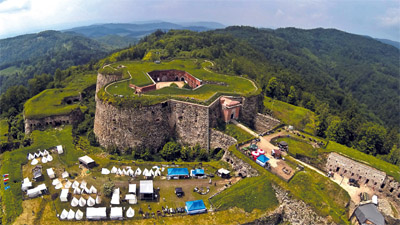 I sure wouldn't want to try to get into that fort without a helicopter. Look at the bottom left, all those guys are so tired of trying to get in that they've pitched tents so they can rest up and try again tomorrow! I sure wouldn't want to try to get into that fort without a helicopter. Look at the bottom left, all those guys are so tired of trying to get in that they've pitched tents so they can rest up and try again tomorrow! |
|
Unfortunately for the unconquered Twierdza Srebrnogórska, the treaty allowed for the creation of the aforementioned Duchy of Warsaw, which essentially handed Silesia, including Srebrna Góra, over to France. Though the fort did the job for which it was designed and was not subdued by violent action, 'twas occupied by Napoleonic troops anyway.
|
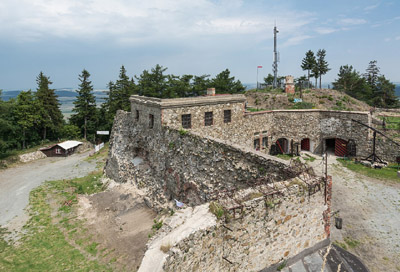 A closer look at Fort Ostrog, known to its creators as Fort Spitzberg. A bit ragged, but still utterly impregnable! A closer look at Fort Ostrog, known to its creators as Fort Spitzberg. A bit ragged, but still utterly impregnable! |
 |
Once Napoleon had been vanquished, our twierdza found itself on land claimed by Austria, Prussia and then the German Empire, once that became an entity in 1870. Just prior to this, however, the Prussians in charge of Silesia determined that Twierdza Srebrnogórska was obsolete, and needed to be "liquidated." This decision was made official on January 1, 1860...but it apparently took seven years to convince all of the troops therein to leave, because who wants to leave a nice warm starfort on top of a hill?
As many authorities have learned through the past few centuries, however, deciding that a well-built starfort should be liquidated, is a great deal easier than actually turning it into liquid. |
|
|
But, you have to give the Prussians points for trying. From 1867 into the 1870's, Twierdza Srebrnogórska was used for target practice, a subject of artillery and explosives testing. It eventually dawned on someone up the line of command that this twierdza was not being efficiently liquified, so why not do the opposite of what they had been doing, and develop it as a tourist attraction instead? Why not, indeed. Following the First World War (1914-1918) the donjon was renovated, and a restaurant was opened therein.
|
Further commercial development was interrupted by that pesky Second World War (1939-1945). Germany used the donjon as a prison for around 300 officers of the Polish military. Nine of those officers affected a daring escape in May of 1940, utilizing the time-honored method of tossing a rope out a window when nobody was looking. Three made it out of the country, and fought on in North Africa.
Our twierdza did not fare well under Soviet occupation (did anyone?), but in 1965 an effort to clean up the major parts of the fort got underway, and the Museum of Heavy Firearms opened in the donjon in May of 1974.
|
 |
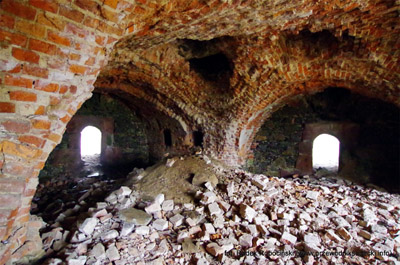 Fort Chochoł Mały isn't visible from above, but it's visible if you go inside of it! Thanks to Radek Robociński for the ankle-threatening photography! Fort Chochoł Mały isn't visible from above, but it's visible if you go inside of it! Thanks to Radek Robociński for the ankle-threatening photography! |
|
Aleksander Kwaśniewski (b.1954), President of the Republic of Poland, declared Twierdza Srebrnogórska a national monument on April 14, 2004, which finally prevented the Prussians from using it for target practice.
Many, many thanks to alert starfort finder Dagne Sheiadhl for pointing out Twierdza Srebrnogórska for us!
|
|
|
|
|
|
 |




